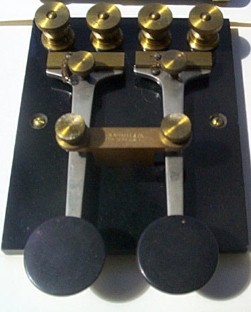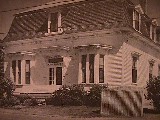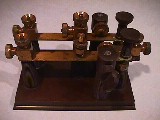Submarine Cable Telegraphy

Because of the length of submarine cable and its capacity to hold
a large amount of charge, the ordinary Morse method of telegraphy was not
practical. The received signals were too weak to be useful. This problem
was overcome by keying the cable with an instrument with two telegraph
keys on one base. When neither key is pressed down,
they both rest against the upper brass strip and the
cable is put directly to ground to drain off any residual charge.
Due to the clever layout of the brass strips and
key levers, if the "dit" contact is depressed (touch it with your mouse), the positive
terminal of the battery is put to the ocean cable and a positive deflection
occurs at the receiver. If the "dash" contact is depressed, the negative
terminal of the battery is put to the submarine cable and a negative deflection
occurs at the receiver. The receiver initially was a Mirror receiver,
in which the deflection of a spot of light from a zero point on a screen up or down meant
dot or dash and was recorded by a clerk. The duration of the deflection had no importance. Later,
the Thomson Siphon Recorder was devised and an ink spot was continuously
deposited on a recording tape for a permanent record of the message.
Adapted from American Telegraphy & Encyclopedia of the Telegraph by William
Maver, Jr.

J.H. Bunnell & Co.
Atlantic Cable Telegraph Key
This key was used in the Montivideo, Uruguay office of American
cables. It is circa 1910 and was acquired for the collection of D.K.
DeNeuf on his visit to Montivideo in 1960. It was framed in a glass
case the last 40 years it was in the DeNeuf collection, prior to its arrival here
at The Sparks Telegraph Key Review. Other manufacturers
made similar cable keys. A cable key consisting of two Steiner keys resides in the
K5RW collection.

This is an example of a portion of submarine cable laid over 100 years ago to Havana, Cuba from
the U.S. Similar cable, though heavier, was laid across the Atlantic Ocean. The larger outer wires
of the cable provided strength and protection. The innermost wire carried the current. This
cable was salvaged from the ocean floor by Tom Perera, W1TP.

The first transatlantic submarine telegraph cable was completed in 1858 and
made landfall from Europe to North America in Newfoundland. Landline routes
then carried the messages as necessary to America. The first direct
transatlantic submarine telegraph cable from Europe to America made landfall
at the Cable House in Rye, New Hampshire in 1874.

Many instruments were devised to aid in maintenance of long submarine cables.
This is called a reversing key, one of many special instruments manufactured to help
with testing of the submarine cables. Reversing keys were used to help eliminate interfering earth current
effects when attempting to measure the resistance of a submarine cable. The two methods used,
called "Quick Reversals" and "False Zero" are described in detail in the Signal Corps Manual No.3,
1916, Chapter 11, p. 39. Pictures of submarine test instruments are also shown there.
The first cable was successfully landed on the 6th of August, 1858, but the first
public despatch, that of the Queen of England to the President of the United States,
was not received until the 17th of August. The text of her message and his response can
be seen below. This first cable only functioned for a
short period of time.
.....from Prescott's History, Theory and Practice of the Electric Telegraph, 1866.
The Republic and the Florida
When anybody mentions disaster at sea, most people think of the Titanic striking an iceberg. But there was another great disaster at sea three years before the Titanic. On January 23rd, 1909, the 7000 ton steamer Florida was traveling not less than 12 knots per hour in fog when it struck the 25,000 ton steamship Republic of the White Star Line off Nantucket lightship. It was a "T-bone" type collision with the bow of the Florida crushing through the side plating of the Republic and entering the engine room. Two passengers were killed on the impact. Jack Binns, the wireless man on the Republic, was asleep in the wireless room at the moment of impact. He sent the distress signal even though the lights went out after about 5 minutes. The distress signal was picked up and the steamer Baltic rescued about 1500 passengers from the Republic. The Republic sank after the collision. But the Florida, with 30 feet of her bow crushed like an accordion into a 5 foot space, steamed under her own power into New York. The pictures above show the Florida in drydock before repair, then with her new bow completed 24 days after repairs were begun, and the wrecked 100 tons of bow squashed into 5 feet thickness after being lifted away from the ship. Click here for more info. From Scientific American, August 28, 1909.
 Back to the Index
Back to the Index






 Back to the Index
Back to the Index